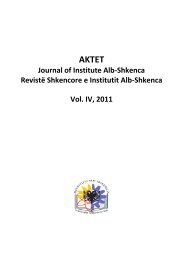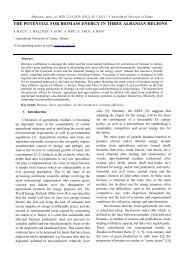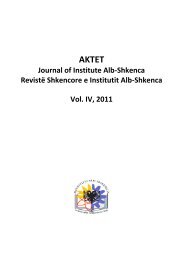Create successful ePaper yourself
Turn your PDF publications into a flip-book with our unique Google optimized e-Paper software.
Caslli et al.rectangular hollow, rectangular solid, circularhollow, section I, angle L, channel U, etc., can bemade out of various materials: steels, aluminumalloys, composites…and even wood, while themost used software’s computer-aided by ourdesigning staffs, are mainly focused on metallicmaterials, and in majority of cases, only on steels.The narrowing search spectrum of solution,favors a quick advance towards the dimension ofcomponent, but at the same time carries the riskof not considering the innovatory options andlosing the opportunities. These limitationsbecome more evident when material – shapeselection needs to satisfy several objectives atthe same time and when the optimal solution canbe achieved only by means of the multiplecriteria selection [2, 4]. These limitation can beavoided by means of several methods such asDargie, Pugh, Dominic, Pahl-Beitz, [5, 11] etc.,among which the performance indices or Ashby’smethod [1, 2], initially conceived only formaterial selection, actually constitutes one of themost seriously references for new developments,including those which deal with the combinedmaterial-shape selection. The aim of this paper isto explore the possibility and utilization of thismethod in a concrete general application dealingwith the selection of some elements often foundin secondary beams in structural constructions.2. THE PRESENTATION OF THE PROBLEM ANDTHE “TRADITIONAL” SOLUTIONThe case in issue represents the structuralsupporter of roof for a warehouse or anemporium object. The construction of thestructure is formed by some trusses with a spamof 24m that are supported on columns at bothends for every 5m. The secondary beams aresupported by two trusses next to each-other andthey must meet the following conditions:- To support the load without failure (thestrength / resistant constraint),- No elastic strain on bend beyond a certainlimit, formulated with a mid-point alloweddeflection, [] l / 250 (the stiffnessconstraint),- The length, or spam of secondary beam is l =5m (fig. 1).Figure 1: Schema of the roof metallic construction and the secondary beam separationThe method by means of which are computedstructural construction components (in presentengineering practice) is done by the limit state[12]. It will be accepted in this presentation thatthe element load (beam) will not exceed thelimit of the material elasticity. To apply thismethod, all the acting loads in the structure(the vertical permanent load and the temporalone * ) are primarily computed and thedetermining of the bending moment that ispressed over the studying component isreached. In this case the moment results:AKTET Vol. IV, Nr 2, 2011 201






